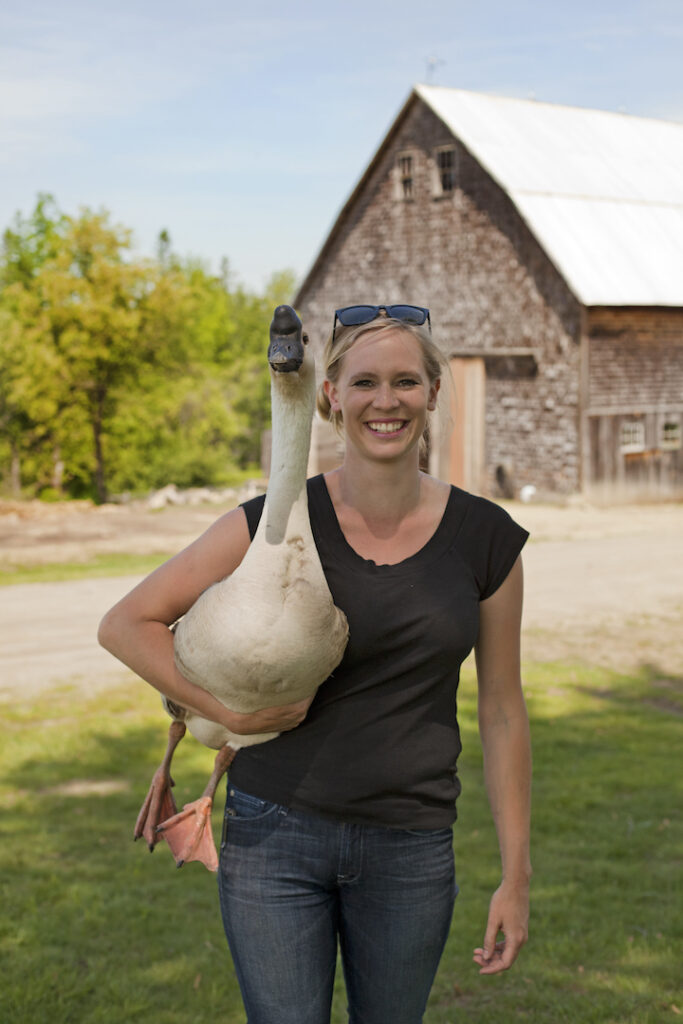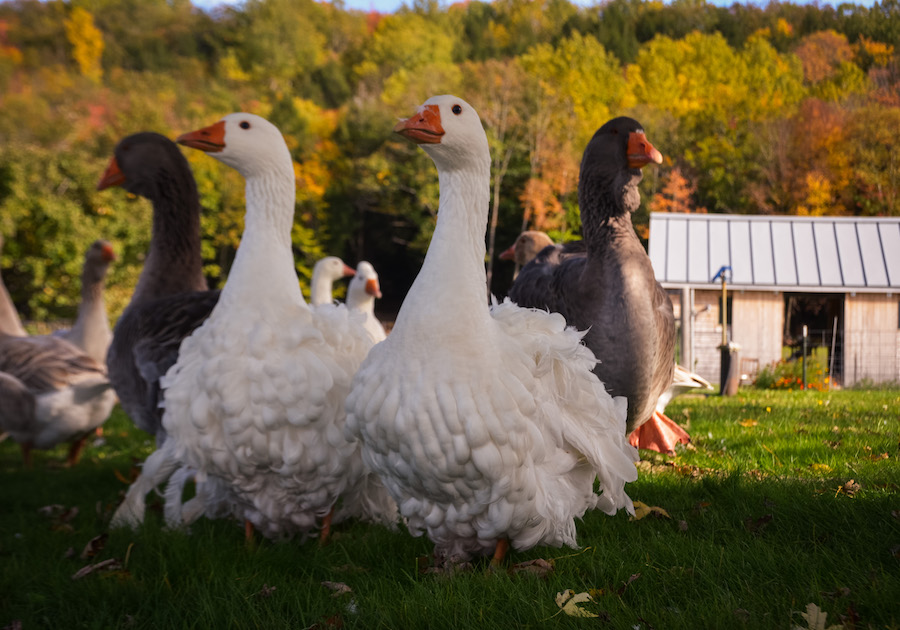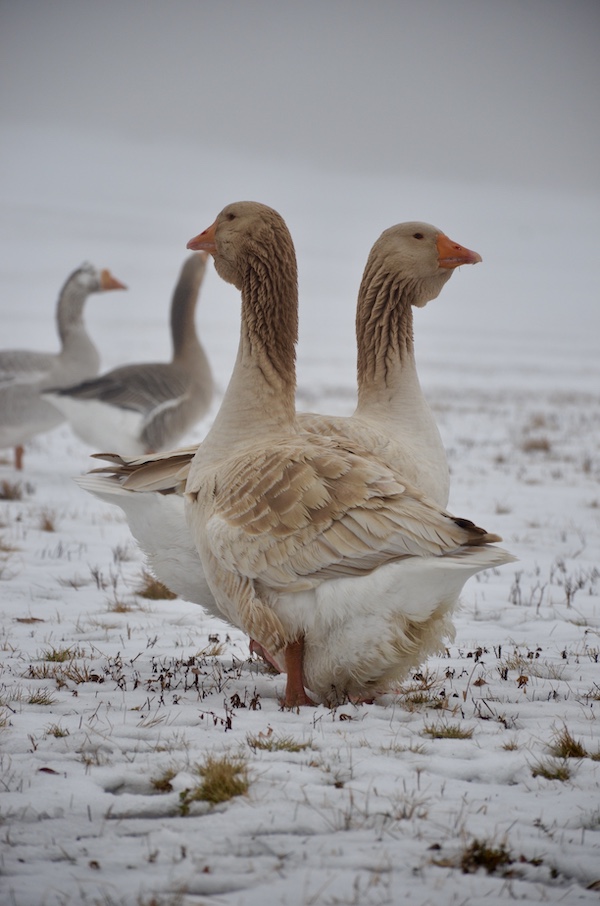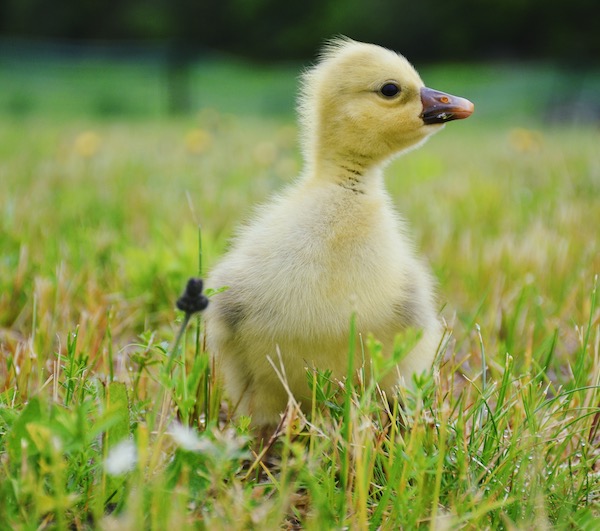By Kirsten Lie-Nielsen
It was 2013, and my husband and I had never raised birds of any kind. Ordering chicks seemed like the logical way to progress our little urban homestead in Maine, and at a whim we added two goslings to our hatchery order. The birds arrived, peeping and squeaking, and it immediately became apparent that geese had different needs from chickens.

Through trial and error over the next few years, we would learn the ins and outs of keeping geese as our flock expanded from two to four to eight to twenty-two. Our flock contained a wide variety of breeds, each with their own personalities and special skills. From the first imprint of the first day-old gosling, geese became a huge part of my life and a focus in our farm’s growth and my writing and research.
One of the first things I learned about geese was how important breed selection is. The breeds of geese vary noticeably in build, color, personality and use, as well as popularity. Our flock’s geese included the following breeds.
African and Chinese
Large and loud, African and Chinese geese are both remarkably upright birds with proud stances and long necks. They are active, with the Chinese goose being particularly known for its energy. The Chinese goose is the smaller of the two breeds and both have a noticeable, bulbous knob at the beginning of their beaks. They are most commonly used for weeding and guarding; loud honks and attentive personalities serve them well in these roles.
Sebastopol
The curly feathered Sebastopol goose is often compared to a line of laundry or a wedding dress in appearance. They have gained in popularity greatly in recent years as a smaller-sized goose with one of the friendliest personalities. Good mothers and egg layers, they are one of the best breeds for a small farm or homestead.

Dewlap Toulouse
The largest breed of goose, the Dewlap Toulouse is also one of the most docile and friendly. More interested in food than aggression, they make excellent pets and are also exceptional egg layers. They aren’t gifted as guardians, however, because they aren’t interested in the energy it takes to complete that job.
Buff
A good all-around goose, the Buff is a unique color and medium size. Bred originally for meat, they can be used interchangeably for eggs, guarding or weeding. The Buff goose is a perfect example of an all-purpose breed, similar to Pilgrims and Embdens.

Roman Tufted
An ancient breed of goose, the Roman Tufted is small and usually friendly but still energetic and attentive enough to make an excellent guard bird.
Most of the geese on our farm came via mail order from a hatchery, the easiest way to ensure that your goslings are of a particular breed. Goslings are much hardier than chicks, and we rarely had any sick goslings upon arrival. Occasionally, we would adopt a bird from Craigslist or a friend, and our birds did hatch their own goslings in the spring. However, adopted adult birds and goslings hatched out by geese are unlikely to form a bond with their human parent, so those geese were always more skittish and less friendly.
However a goose arrived at our farm, a few key things were required to properly care for new goslings. A brooder for geese is similar to one for chicks, but with a few key differences. Goslings grow at an exceptional rate, so spaces for them should be set up with areas that they can expand into as they grow. Goslings require the ability to dip their entire bills into water to keep their nostrils clean — but do not need a full swimming or bathing area in their brooder, in fact it will immediately become a mess. A small tray with an inch of water is sufficient.
Both goslings and adult geese require niacin in their diet, as do ducks and ducklings. Therefore, they cannot eat the same feed as chicks and chickens because it won’t fulfill their nutritional requirements. Instead, goslings and geese should eat a special waterfowl or game bird feed with niacin included, or have the vitamin supplemented by adding brewer’s yeast to their feed at a ratio of 3 pounds brewer’s yeast to 25 pounds of feed.
Perhaps the most notable thing about goslings when compared to chicks is how quickly and completely they will imprint on their caretaker. They will form an unbreakable bond with the person who first feeds and cares for them. Imprinted goslings follow their parents or people around at all times, sticking as close as they can be peeping urgently when separated. This behavior is instantly endearing but depending on the purpose of geese on your farm it may not be desirable.
Our geese were raised primarily for companionship, though they also helped keep our lawns trim and prevented predators from bothering our chickens. Common uses for geese on the farm include meat production, lawn maintenance and guarding. The wonderful thing about geese is how easily their natural behaviors can be utilized to perform these tasks — they require no training and very little human interference.
Geese are strict vegetarians, so their constant interest in anything growing and green makes them wonderful at keeping lawns trim. They are most commonly used around orchards, vineyards and berry bushes where their long necks make them particularly effective, but they won’t bother the established crop. They are ineffective in a vegetable garden where they will just as happily eat your vegetables as the weeds. In an orchard or open lawn, the only challenge is to make sure you have enough geese to manage the space — approximately 10 geese an acre for a nicely trimmed lawn. Moveable electric fencing can be used to manage the birds, moving them from area to area as their work is completed.
When it comes to guarding, the theories on geese vary. A single goose raised with chickens will see them as their flock, imprinting on them, and will protect them fiercely. A large group of geese won’t imprint on your chickens or care for their wellbeing, but will be more intimidating to a predator. When considering a goose as a guard animal, keep in mind that they are still prey for many farm predators. Geese are effective at warding off nuisances as large as weasels and skunks but not animals much bigger — and can be carried away by a coyote or an eagle.

As your goslings grow up — and goslings grow up quickly — they’ll need some full-sized housing. Unlike chickens, geese require only minimal shelter and no nesting boxes or roosts. They sleep on the ground and make their nests in corners and private areas of their coop, shelter or yard. A goose house should provide protection from the elements and be full of clean, thick bedding. It should offer at least 8 square feet per bird, more if your geese will be inside frequently due to weather.
Our geese had a large stall in our barn, which offered enough space for 22 birds to sleep at night but not enough for them to remain cooped for longer, especially during breeding season when sometimes violent squabbles would erupt. Because our property was open and private, we allowed our birds to free range rather than creating a run space for them. Free range birds are always happier birds, and generally healthier birds — but, unfortunately, free ranging is what brought about the end of our flock.
In March of 2022, we lost our entire bird flock to Highly Pathogenic Avian Influenza. This incredibly aggressive virus has continued to ravage bird flocks around the world since mutating into a more virulent, more deadly version of the standard “bird flu” in the winter of 2021-2022. It is highly transmissible among wild bird flocks, but wild birds such as ducks, geese and turkeys often carry the virus without symptoms. A bird can catch avian flu by interacting with a wild bird that carries it or by swimming in water that a wild bird has contaminated.
The tragedy of avian flu is that because it is so transmissible and we do not fully understand how long it remains as a virus within geese that do recover from it, if one bird in your flock has the virus it is the policy of the Centers for Disease Control and Prevention (CDC) and the U.S. Department of Agriculture (USDA), as well as common sense, to euthanize the entire flock. You would not want a wild bird stopping at your farm, picking up the virus from your remaining birds, and spreading it to other farms. Or, even worse, a friend farmer visiting you and tracking it home to their birds on their shoes. Therefore, maximum precautions are taken.
To lose our birds was an incredible tragedy. Imprinted geese are more than just livestock, they are pets and even friends. These birds had been with us through thick and thin, two homes, family events, the addition of many other animals, and much more. They were the inspiration for my first book, “The Modern Homesteader’s Guide to Keeping Geese,” and featured in other books and magazines during their full and wonderful lives. After this experience, it was at first hard to consider adding birds back simply because of the fresh hurt of this loss.
I now understand the steps I would take to prevent the avian flu if geese return to our farm. Our flock had no run and our indoor space was too small to keep them inside longer than overnight. In the future, part of our plans for any birds would include quarantine areas that could hold the entire flock for months at a time if necessary. This would mean getting far fewer birds — perhaps as few as two or three — but would allow us to ensure their health throughout their lives.
Geese provide delight, entertainment and service to a large farm or small homestead. While keeping birds today is riskier than it has been in the past, even avian flu can be avoided with planned precautions.
Kirsten Lie-Nielsen is an author and farmer in Liberty, Maine, where she and her husband are restoring a 200-year-old farm and raising Nigerian Dwarf goats and Babydoll sheep. She is the author of two books on homesteading, “The Modern Homesteader’s Guide to Keeping Geese” and “So You Want to Be a Modern Homesteader,” and she shares farming knowledge via her website and social media, as well as offering occasional classes. She can be found at hostilevalleyliving.com.
This article originally appeared in the spring 2023 issue of The Maine Organic Farmer & Gardener.
